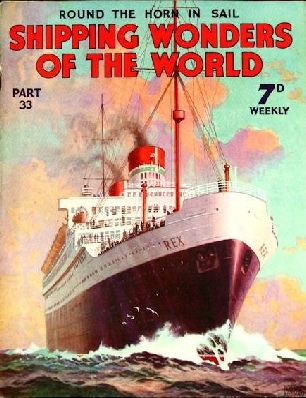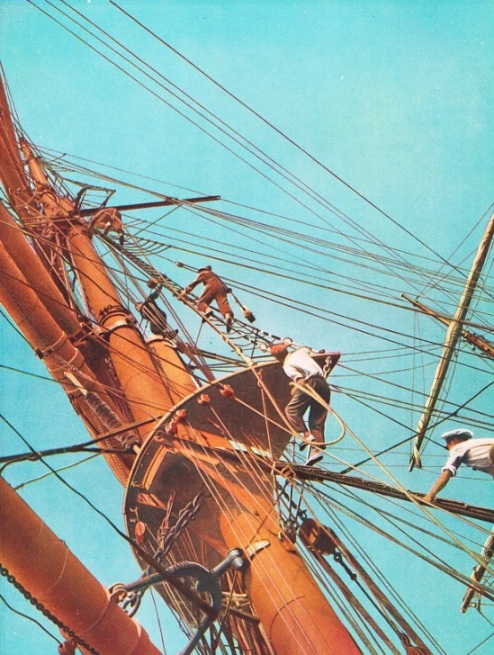
© Shipping Wonders of the World 2012-



Part 33
Part 33 of Shipping Wonders of the World was published on Tuesday 22nd September 1936.
This issue included a colour plate illustrating Going Aloft on Board the Archibald Russell, which formed part of the article on Sailing Round the Horn. The plate had previously appeared as the cover to Part 8.
The Cover
This week’s cover shows the Rex, belonging to the Italia Line. The Rex, a quadruple-screw turbine steamer of 51,062 tons, won the Blue Riband of the Atlantic in August 1934, when she averaged 28.92 knots from Gibraltar to Ambrose Light, New York. The cover supplements the article on Italian Shipping in this issue.

Contents of Part 33
The Battle of Lepanto
The story of the Battle of Lepanto, concluded from part 32.
Britain’s Changing Coast Line
The loss of land due to the encroachment of the sea is serious and spectacular. The principal cause is the combined action of waves, tides and currents. Various measures have been devised to deal with the problem, but they have to be applied with prudence and caution. Coast erosion is a subject which is very little understood by “the man in the street”. This chapter describes notable instances of the action of the sea on the land, and of the steps which are taken to prevent portions of our coast-line from slipping away into the sea.
Italian Shipping
Although the foundations of Italian shipping were laid in the commerce of the Roman Empire and in the medieval prosperity of such cities as Genoa and Venice, the modern Italian merchant fleet is a vigorous product of Government action. It was from a wrecked Carthaginian galley that the Romans learnt the beginnings of their sea power. From those early times, through the Renaissance period, when Venice was the world’s great merchant port, right down to the present day, Italy has held a significant place in the story of the sea. An Italian liner, the Rex (illustrated on the cover of this part), gained the Blue Riband of the Atlantic in 1934. This chapter touches on the historical aspect of the subject and deals in detail with Italy’s Mercantile Marine at the present time.
It is the seventh article in the series on Sea Transport of the Nations.
Floating Docks
Remarkable progress has been made in the design of great floating docks - hospitals for giant ships - in recent times, particularly since the coming of the mammoth liner has brought special problems of rapid overhaul. The earliest kind of floating dock is said to have been invented in Russia by an Englishman during the reign of Peter the Great. It was simply an old hulk hollowed out and fitted with a water-tight gate at the stern. From such humble beginnings have grown some masterpieces of modern engineering. One example is the enormous floating dock at Southampton, which has a lifting power of 60,000 tons.
Sailing Round the Horn
A vivid first-hand account of the voyage of an apprentice in a large sailing ship round “the world’s worst corner” at the beginning of this century. These are the days of steamships and the Panama Canal, but there are still many men who can remember the hardships and miseries of that adventurous voyage in sail round Cape Horn. Terrific wind, extreme cold and steep seas were everyday conditions, and often the supply of warm, nourishing food ran short. The courage and endurance of sailors who made the voyage round “Cape Stiff” were magnificent. This chapter not only tells of the rigours of the passage round the Horn, but it also shows us the “human side” of life at sea and introduces some characteristic old sailors.
Going Aloft (colour plate)
Contents of Part 33 (continued)
River Plate Cargo Ships
A description of the Aguila II whose job is to carry quebracho, a tree bark much used for tanning purposes. The Aguila II has a length of 260 feet, a beam of 42 feet and a depth of 11 ft 9 in. She was completed in 1931 at Leith and engined with two Atlas diesels.
This is the twenty-fifth article in the series on Merchant Ship Types.
Singapore - Crossroads of the East
Apart from its importance as one of the world’s great ports, Singapore is particularly interesting because its commerce is set amid the glamour of the East. Formerly a haunt of Oriental pirates, Singapore is now a centre for picturesque native craft and fishermen who work by most unusual methods.
This chapter is the tenth article in the series on Great Ports of the World. The article is concluded in part 34.
